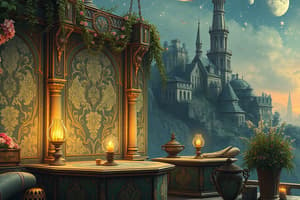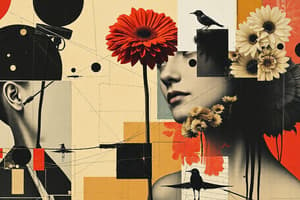Podcast
Questions and Answers
Which element of art is most responsible for creating a sense of depth and realism in a two-dimensional artwork?
Which element of art is most responsible for creating a sense of depth and realism in a two-dimensional artwork?
- Texture
- Form (correct)
- Color
- Line
In art, what is the role of 'space' as an element?
In art, what is the role of 'space' as an element?
- To determine relationships between objects, create depth, and convey perspective. (correct)
- To enhance the tactile quality of artwork.
- To primarily evoke mood and express emotions.
- To provide the basic forms that make up a composition.
Which of the following best describes the function of 'value' as an element of art?
Which of the following best describes the function of 'value' as an element of art?
- Using contrasts between light and dark areas to create depth and emphasize shapes. (correct)
- Guiding the viewer's eye and conveying emotion through the use of strokes.
- Organizing elements and creating patterns within a composition.
- Expressing emotions and creating visual interest through different hues.
How does 'texture' contribute to an artwork?
How does 'texture' contribute to an artwork?
In the context of art, what does 'transcreation' primarily involve?
In the context of art, what does 'transcreation' primarily involve?
Which element of art is primarily responsible for evoking mood, expressing emotions, and creating visual interest?
Which element of art is primarily responsible for evoking mood, expressing emotions, and creating visual interest?
What is the main role of 'line' as an element of art?
What is the main role of 'line' as an element of art?
How does 'shape' function within a composition?
How does 'shape' function within a composition?
What distinguishes 'appropriation' as a factor in transcreation?
What distinguishes 'appropriation' as a factor in transcreation?
When an artist employs 'distortion' in transcreation, what are they primarily doing?
When an artist employs 'distortion' in transcreation, what are they primarily doing?
In transcreation, what does 'transformation' involve?
In transcreation, what does 'transformation' involve?
Which principle of art ensures that all elements in a composition work together harmoniously to create a cohesive whole?
Which principle of art ensures that all elements in a composition work together harmoniously to create a cohesive whole?
What does 'balance' refer to in the principles of art?
What does 'balance' refer to in the principles of art?
What is the role of 'emphasis' in an artwork?
What is the role of 'emphasis' in an artwork?
How does 'contrast' enhance a piece of art?
How does 'contrast' enhance a piece of art?
What is the function of 'proportion' in art?
What is the function of 'proportion' in art?
What is the primary effect of 'pattern' in an artwork?
What is the primary effect of 'pattern' in an artwork?
What is the purpose of 'variety' in the principles of art?
What is the purpose of 'variety' in the principles of art?
How does the Rule of Thirds structure a composition?
How does the Rule of Thirds structure a composition?
In the Rule of Thirds, what is the purpose of the focal points?
In the Rule of Thirds, what is the purpose of the focal points?
According to the principles of the Rule of Thirds, what is generally recommended when applying focal points?
According to the principles of the Rule of Thirds, what is generally recommended when applying focal points?
Which principle of art is most closely related to creating a focal point within a composition?
Which principle of art is most closely related to creating a focal point within a composition?
Which of the following is an example of 'unity' in art?
Which of the following is an example of 'unity' in art?
If an artwork is said to have asymmetrical balance, what does this imply?
If an artwork is said to have asymmetrical balance, what does this imply?
Which artist reinterpreted Hiroshige's woodblock print 'Bridge in the Rain', by changing its colors, shapes and brushstrokes?
Which artist reinterpreted Hiroshige's woodblock print 'Bridge in the Rain', by changing its colors, shapes and brushstrokes?
Flashcards
Elements of Art
Elements of Art
Building blocks artists use to create art, essential for any artwork.
Line (Art Element)
Line (Art Element)
Gives structure and shape, guiding the viewer's eye and conveying emotion.
Shape (Art Element)
Shape (Art Element)
Provides basic forms, organizes elements, and creates patterns in a composition.
Color (Art Element)
Color (Art Element)
Signup and view all the flashcards
Space (Art Element)
Space (Art Element)
Signup and view all the flashcards
Texture (Art Element)
Texture (Art Element)
Signup and view all the flashcards
Value (Art Element)
Value (Art Element)
Signup and view all the flashcards
Form (Art Element)
Form (Art Element)
Signup and view all the flashcards
Transcreation
Transcreation
Signup and view all the flashcards
Distortion (Transcreation)
Distortion (Transcreation)
Signup and view all the flashcards
Transformation (Transcreation)
Transformation (Transcreation)
Signup and view all the flashcards
Appropriation (Transcreation)
Appropriation (Transcreation)
Signup and view all the flashcards
Principles of Art
Principles of Art
Signup and view all the flashcards
Unity (Art Principle)
Unity (Art Principle)
Signup and view all the flashcards
Balance (Art Principle)
Balance (Art Principle)
Signup and view all the flashcards
Emphasis (Art Principle)
Emphasis (Art Principle)
Signup and view all the flashcards
Contrast (Art Principle)
Contrast (Art Principle)
Signup and view all the flashcards
Proportion (Art Principle)
Proportion (Art Principle)
Signup and view all the flashcards
Pattern (Art Principle)
Pattern (Art Principle)
Signup and view all the flashcards
Variety (Art Principle)
Variety (Art Principle)
Signup and view all the flashcards
Rule of Thirds
Rule of Thirds
Signup and view all the flashcards
Focal Points (Rule of Thirds)
Focal Points (Rule of Thirds)
Signup and view all the flashcards
Study Notes
The Elements of Art
- These are the building blocks required to produce art
- Understanding these elements allows for evaluation, explanation, and shared expression about art
- Line imparts artwork structure and shape
- Line guides the viewer's eye and conveys emotion or movement
- Shape provides compositions with basic forms
- Shape organizes elements and creates patterns
- Color evokes mood, expresses emotions, and creates visual interest
- Colors convey symbolism and highlight focal points
- Space determines object relationships in composition
- Space creates depth, perspective, and a sense of openness or confinement
- Texture enhances the tactile quality of artwork
- It makes artwork visually and physically interesting by suggesting how surfaces feel
- Value contrasts light and dark areas
- It creates depth, emphasizes shapes, and gives objects solidity
- Form adds depth and realism
- Form represents three-dimensional objects to give volume
Transcreation
- This involves reinterpreting/adapting creative works
- It preserves the original essence and purpose in new cultural contexts
- Creative adaptation and cultural sensitivity maintains the original artistic vision
Examples of transcreation
- Vincent Van Gogh was influenced by Japanese woodblock prints
- Van Gogh's "The Courtesan (after Eisen)" was inspired by Keisai Eisen
- It reflects fascination with Japanese art and contemporary magazine images using unique color and style
- Van Gogh’s “Bridge in the Rain (after Hiroshige)” was directly inspired by a Japanese print by Utagawa Hiroshige
- Auguste Rodin’s “The Thinker” influenced modern sculpture
- Artists adapted expressive forms/themes to address contemporary issues while preserving their emotional and psychological impact
- Aristide Maillol's “La Nuit, 1902-1909” was inspired by Rodin’s innovative style
Factors Influencing Transcreation
- Distortion changes the original piece's characteristics(shape, color, form)
- Example: Van Gogh's "Bridge in the Rain (after Hiroshige)" reinterprets Hiroshige’s woodblock print with changes to colors, shapes, and brushstrokes
- The result is a vivid, swirling painting with contrasts, reflecting Van Gogh's style and personal touch
- Transformation changes the medium or context of the original work
- Example: Salvador Dalí’s “The Persistence of Memory” as a 3D digital model
- Appropriation uses elements from an existing work to create something new
- Example: Van Gogh's "The Courtesan (after Eisen)" reinterprets Keisai Eisen's Japanese woodblock print, keeping the subject/composition but modernizing the brushwork, colors, and expression
The Principles of Art
- These principles are fundamental guidelines that organizes art elements
- They create coherence, guide the viewer, and enhance aesthetic quality
- Unity ensures all composition elements work together harmoniously to create a cohesive whole
- Example: Sandro Botticelli's "The Birth of Venus" uses harmonious figures, colors, and composition
- Balance distributes visual weight in a composition
- Balance can be symmetrical (equal weight on both sides), asymmetrical (unequal balance achieving harmony), or radial (balance around a central point)
- Example: Vincent Van Gogh's "The Starry Night" uses asymmetrical balance, with the swirling sky balanced by the village and cypress tree
- Emphasis is the focal point that attracts attention, often through contrast, size, or placement
- Example: Salvador Dalí’s “The Persistence of Memory” and the unusual melting clocks
More Principles of Art
- Contrast is the noticeable difference between elements, enhancing their strengths
- Example: Wassily Kandinsky's "Composition VIII" uses contrasting colors, shapes, and sizes
- Proportion refers to the size relationships between different composition elements to maintain harmony and scale
- Example: Leonardo da Vinci's "Vitruvian Man" illustrates ideal human proportions based on Vitruvius' writings
- Pattern arranges alternated/repeated elements like shapes, lines, colors, or motifs
- Example: Katsushika Hokusai's "The Great Wave Off Kanagawa" features dynamic, stylized waves creating a rhythmic pattern
- Variety uses several design elements to hold attention and guide the viewer's eye
- Example: Andy Warhol's "Campbell's Soup Cans" repeats soup cans as a motif but varies colors and arrangements
Rule of Thirds
- An image is divided into thirds horizontally and vertically
- Artists use horizontal lines to separate foreground and background
- Overlapping areas of the red circles are focal points
- Focal points are used to draw the viewer's attention
- It is better to emphasize only some of the focal points
- Samuel Peploe's Still Life with Coffee Pot (c. 1905) uses the Rule of Thirds
- The horizontal line of the table edge runs along the bottom third of the painting
- The reflected light down the center of the teapot is on a vertical line two-thirds of the way across the frame
- The bright orange and lemon to the left of the frame sit at one of the focal points
Studying That Suits You
Use AI to generate personalized quizzes and flashcards to suit your learning preferences.




